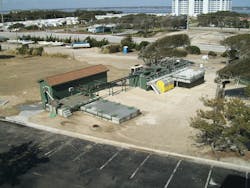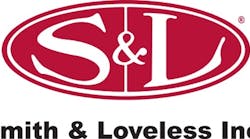Smith & Loveless, www.smithandloveless.com, 913.888.5201
When developers of a condominium complex sourced wastewater treatment systems, it did so with two primary requirements: efficient land utilization and high effluent quality to meet stringent guidelines. Located in the quaint fishing village of Indian Beach, N.C., the planned development included more than 200 condominium units near oceanside property.
State regulators advised the developers to discuss combining its wastewater system with the owner’s association of an adjacent housing development, whose existing wastewater treatment system was aging and required augmentation. The combined scheme required a 101,000 gal per day (382 cu meters per day) treatment system with screening that was expected to experience daily flows as low as 60,000 gpd (227 cmd).
Land costs were extremely high for this coveted property and a system that would minimize land usage to keep project costs down was required. The existing subsurface disposal field necessitated a treatment system capable of producing high quality effluent that could be reused or reclaimed. Influent BOD and TSS was rated at 250 mg/L.
Solution
The parties considered a number of system options before ultimately selecting the packaged TITAN MBR (Membrane BioReactor) wastewater treatment system from Smith & Loveless. The packaged TITAN MBR provides commercial and private developers a cost-effective solution for enhanced wastewater treatment and water reuse. The developers carefully considered other treatment system alternatives and references from similar private developers in the area before making their decision.
This MBR features a compact system design to produce high quality effluent that exceeds even the most stringent regulatory standards (including California Title 22) for direct discharge and secondary reuse applications. The packaged system features a minimal footprint of 48 ft (14.6 meters) by 12 ft (3.6 meters). It is factory-built and tested and is shipped directly to the job site. Upon delivery, installation requires only basic electrical, influent and effluent connections, as well as the installation of any fine screening. The developer’s project included complete automatic fine screening, pre-wired instrumentation and programmable logic controller equipment.
Result
S&L provided the developer with project support from beginning to end, starting with design calculations, process guidance and engineering drawings. The packaged MBR treatment plant arrived at the developer’s site in North Carolina in a complete and compact factory-built system that required minimal field assembly. Installation and start-up was complete in less than a few days by S&L personnel, as well.
Since installation, S&L high-performance flat-sheet membrane modules have helped the development meet permit requirements while also providing high-quality effluent that is suitable for direct subsurface discharge. The system capably handles a variety of flows while taking up a minimal amount of valuable beachfront property. More housing units were able to be installed because of its small footprint, generating more annual revenue for the development.
The North Carolina packaged system has provided nearly a decade of dependable service to its two residential communities with no major issues. Regular maintenance is safer for operators and less frequent when compared to the other treatment alternatives considered by the development.



